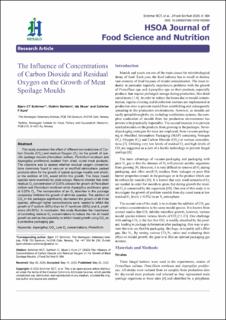| dc.contributor.author | Schirmer, Bjørn Christian | |
| dc.contributor.author | Sørheim, Oddvin | |
| dc.contributor.author | Skaar, Ida | |
| dc.contributor.author | Kure, Cathrine Finne | |
| dc.date.accessioned | 2021-01-11T12:08:10Z | |
| dc.date.available | 2021-01-11T12:08:10Z | |
| dc.date.created | 2021-01-08T10:39:28Z | |
| dc.date.issued | 2020 | |
| dc.identifier.issn | 2470-1076 | |
| dc.identifier.uri | https://hdl.handle.net/11250/2722360 | |
| dc.description.abstract | This study examined the effect of different concentrations of Carbon Dioxide (CO2) and residual Oxygen (O2) on the growth of specific spoilage moulds (Penicillium solitum, Penicillium nordicum and Aspergillus proliferans) isolated from dried, cured meat products. The objective was to assess whether residual oxygen concentrations commonly found in vacuum or modified atmosphere packed products allow for the growth of typical spoilage moulds and whether the addition of CO2 would inhibit this growth. The three mould species were examined by plate assays. Results showed that even residual O2 concentration of 0.05% allowed for growth of Penicillium solitum and Penicillium nordicum while Aspergillus proliferans grew at 0.25% O2. The incorporation of an O2 absorber in the package completely inhibited the growth of all three species. The addition of CO2 in the packages significantly decreased the growth of all three species, although higher concentrations were needed to inhibit the growth of P solitum (80%) than for P. nordicum (60%) and A. proliferans (40-50%). In conclusion, this study illustrates the importance of controlling residual O2 concentrations to reduce the risk of mould growth as well as the possibility to inhibit mould growth using CO2 as a protective packaging gas. | |
| dc.language.iso | eng | |
| dc.subject | CO2 | |
| dc.subject | CO2 | |
| dc.subject | Aspergillus | |
| dc.subject | Aspergillus | |
| dc.subject | Low O2 | |
| dc.subject | Low O2 | |
| dc.title | The Influence Of Concentrations Of Carbon Dioxide And Residual Oxygen On The Growth Of Meat Spoilage Moulds | |
| dc.type | Journal article | |
| dc.description.version | publishedVersion | |
| dc.source.volume | 6 | |
| dc.source.journal | Journal of Food Science & Nutrition | |
| dc.source.issue | 064 | |
| dc.identifier.doi | 10.24966/FSN-1076/100064 | |
| dc.identifier.cristin | 1867560 | |
| dc.relation.project | Norges forskningsråd: 244627 | |
| dc.relation.project | Nofima AS: 11316 | |
| cristin.ispublished | true | |
| cristin.fulltext | original | |
